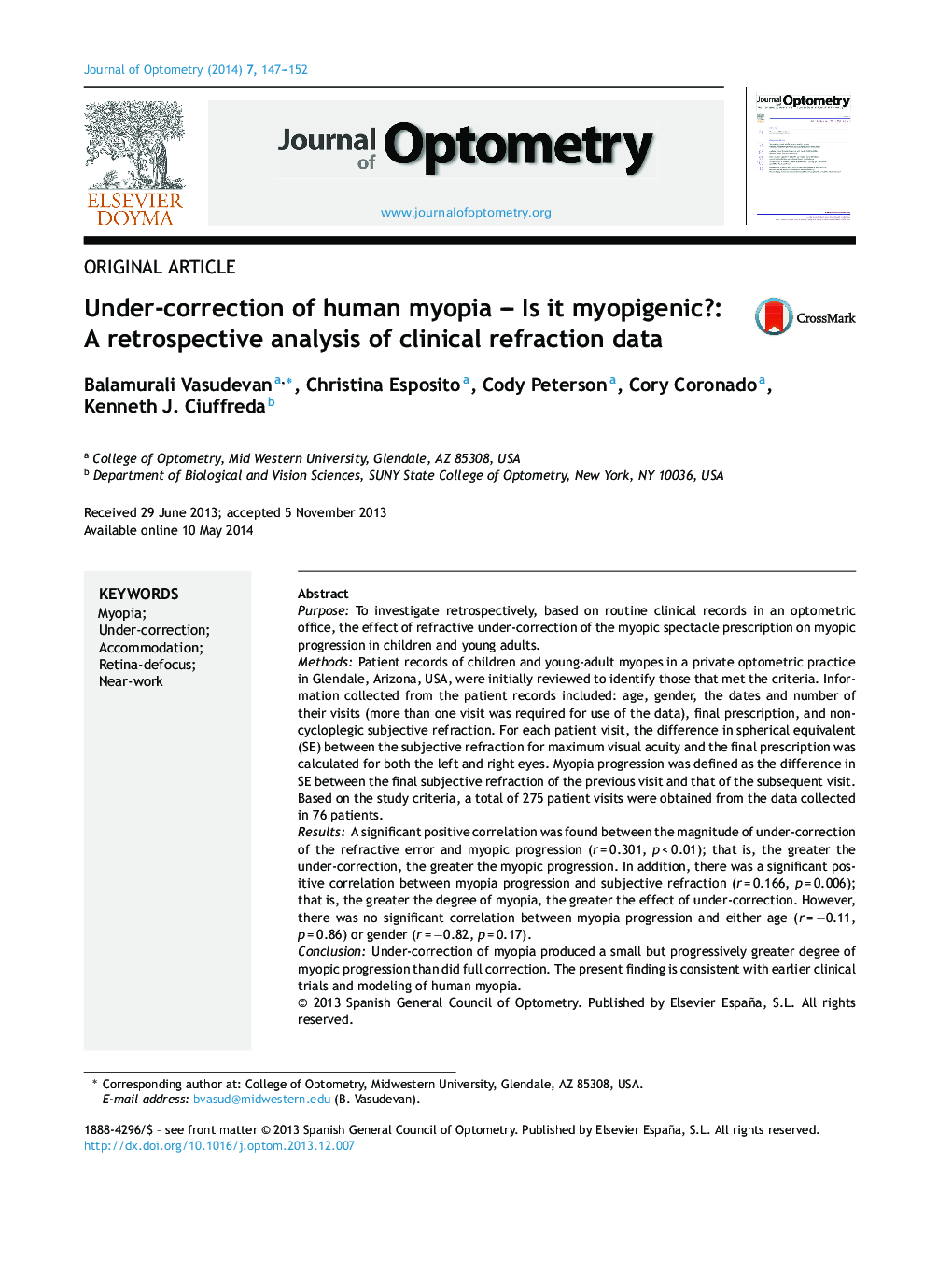| Article ID | Journal | Published Year | Pages | File Type |
|---|---|---|---|---|
| 2695055 | Journal of Optometry | 2014 | 6 Pages |
PurposeTo investigate retrospectively, based on routine clinical records in an optometric office, the effect of refractive under-correction of the myopic spectacle prescription on myopic progression in children and young adults.MethodsPatient records of children and young-adult myopes in a private optometric practice in Glendale, Arizona, USA, were initially reviewed to identify those that met the criteria. Information collected from the patient records included: age, gender, the dates and number of their visits (more than one visit was required for use of the data), final prescription, and non-cycloplegic subjective refraction. For each patient visit, the difference in spherical equivalent (SE) between the subjective refraction for maximum visual acuity and the final prescription was calculated for both the left and right eyes. Myopia progression was defined as the difference in SE between the final subjective refraction of the previous visit and that of the subsequent visit. Based on the study criteria, a total of 275 patient visits were obtained from the data collected in 76 patients.ResultsA significant positive correlation was found between the magnitude of under-correction of the refractive error and myopic progression (r = 0.301, p < 0.01); that is, the greater the under-correction, the greater the myopic progression. In addition, there was a significant positive correlation between myopia progression and subjective refraction (r = 0.166, p = 0.006); that is, the greater the degree of myopia, the greater the effect of under-correction. However, there was no significant correlation between myopia progression and either age (r = −0.11, p = 0.86) or gender (r = −0.82, p = 0.17).ConclusionUnder-correction of myopia produced a small but progressively greater degree of myopic progression than did full correction. The present finding is consistent with earlier clinical trials and modeling of human myopia.
ResumenObjetivoInvestigar retrospectivamente, basándonos en las historias clínicas rutinarias en un centro optométrico, el efecto de la corrección refractiva insuficiente de la prescripción de gafas para miopía sobre la progresión de esta patología en niños y jóvenes adultos.MétodosSe revisaron inicialmente las historias clínicas de niños y jóvenes adultos miopes en un centro optométrico privado de Glendale, Arizona, EEUU, para identificar quiénes cumplían los criterios. La información obtenida de las historias de los pacientes incluyó: edad, sexo, fechas y número de visitas (se requirió más de una visita para poder utilizar la información), prescripción final, y refracción subjetiva no ciclopléjica. Se calculó para cada paciente la diferencia del equivalente esférico (EE) entre la refracción subjetiva para la agudeza visual máxima y la prescripción final, para el ojo derecho y el izquierdo. La progresión de la miopía se definió como la diferencia de EE entre la refracción subjetiva final de la visita anterior y la de la visita siguiente. Basándonos en los criterios de estudio, se obtuvo un total de 275 visitas de pacientes de la información recogida de 76 pacientes.ResultadosSe halló una correlación positiva considerable entre la magnitud de corrección insuficiente del error refractivo y la progresión de la miopía (r = 0,301, p < 0,01); es decir, cuanto mayor era la insuficiencia de la corrección, mayor era la progresión de la miopía. Además, existía una correlación positiva significativa entre la progresión de la miopía y la refracción subjetiva (r = 0,166, p = 0,006); es decir, cuanto mayor era el grado de miopía, mayor era el efecto de la corrección insuficiente. Sin embargo, no existió correlación significativa entre la progresión de la miopía y la edad (r = −0,11, p = 0,86) o el sexo (r = −0,82, p = 0,17).ConclusiónLa corrección insuficiente de la miopía produjo un pequeño aunque progresivamente mayor grado de progresión de la miopía que la corrección total. El presente hallazgo es consistente con estudios clínicos anteriores y la modelación de la miopía humana.
